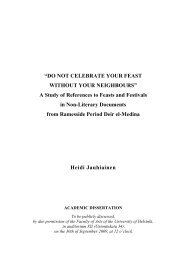BIA
bia51
bia51
Create successful ePaper yourself
Turn your PDF publications into a flip-book with our unique Google optimized e-Paper software.
JANVIER 2015<br />
northern half of the enclosure remained free of<br />
buildings.<br />
Traces of a gypsum floor were found,<br />
indicating that it was used as a courtyard. “The<br />
purpose of the enclosure and the structures in<br />
its interior remains unclear,” ARNOLD said,<br />
adding that it was not a chapel or a palace or<br />
a regular temple. There are three theories<br />
about its original use, as it was built during the<br />
life of the king and used during his lifetime<br />
and not after his death, like the Valley Temple<br />
of his Pyramid Complex.<br />
Due to the age of the root remains of the<br />
trees, ARNOLD said that the building could have<br />
been used for just five years. “It was a<br />
temporary structure,” he concluded.<br />
The first theory, the best one, says that the<br />
structure could have been a temple where<br />
special festivals or ceremonies for a living king<br />
were held and not for eternity like in the Valley<br />
Temple. “It could have been a place to<br />
celebrate the renewal of the king, for example,”<br />
ARNOLD said.<br />
The second theory says that the complex is<br />
a direct predecessor of the limestone Valley<br />
Temple built later in its vicinity, though its<br />
ground plan does not share any features with<br />
the temple, such as the wing of entrance<br />
rooms in the south and the courtyard in the<br />
north.<br />
The third theory is that the building was a<br />
temple for the cult of the king with a garden,<br />
but missing the features of a regular temple as<br />
it was constructed entirely out of brick. No<br />
chapel has been found or any kinds of stelae,<br />
statues or false doors.<br />
It cannot be ruled out that the king was<br />
present in the building as a living person,<br />
rather than as a statue. In this sense the<br />
structure could have been related in purpose<br />
and meaning to the funerary enclosures of the<br />
First and Second Dynasty at Abydos or the<br />
sacred enclosures familiar from depictions of<br />
burial rituals.<br />
“The brick building can be dated to the<br />
middle of the reign of king Senefru,” ARNOLD<br />
told the Weekly, adding that it could have been<br />
erected at the time that work started on the<br />
Bent Pyramid in the eighth year of Senefru’s<br />
reign. The building could thus have been used<br />
until the Valley Temple was erected in the 15 th<br />
year of Senefru’s reign.<br />
The construction of the Valley Temple<br />
respected the location of the brick building,<br />
and the earlier structures do not seem to have<br />
been used after the temple was completed.<br />
Most of the brick walls are covered with the<br />
building debris of the temple. The thick<br />
enclosure wall was later entirely removed and<br />
replaced by a new, much thinner wall. The new<br />
enclosure wall did encompass most of the<br />
space formally occupied by the brick enclosure,<br />
however.<br />
Visual photo illustrating the garden with palm trees<br />
The garden was also extended to the north<br />
along the slope of a low hill. Two additional<br />
rows of plants were added. In several cases<br />
the roots of bushes have been preserved in<br />
this part of the garden. How much of the<br />
original garden remained in use is unclear. In<br />
some areas, plants were added later,<br />
sometimes replacing earlier ones.<br />
“It is a very important discovery that could<br />
change ideas of the function of the Pyramid<br />
Complex, especially the Valley Temple,” ARNOLD<br />
told the Weekly. While the specific function and<br />
meaning of the structure remains unclear, he<br />
said the building adds a new facet to our<br />
knowledge and understanding of the origins of<br />
pyramid temples at the beginning of the Old<br />
Kingdom and the purposes behind their<br />
construction.<br />
“Though possibly related to other building<br />
types of the period, the structure in its design,<br />
and especially in its extensive integration of<br />
plants, is something new and so far unique,”<br />
ARNOLD said. “Buildings of a similar kind may<br />
indeed have existed in the vicinity of the valley<br />
temples of other pyramid complexes, but no<br />
one has yet unearthed one.” (Nevine El-Aref,<br />
<strong>BIA</strong> LI — Janvier/Juin 2015 26



